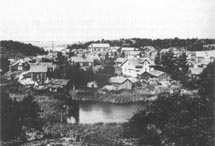|
The prehistoric times
|
| |
At Harstena's outermost parts are the remains of a cairn and a prehistoric grave located more than 15 meters above the sea level. These remains could be from the Bronze Age but since more prehistoric graves have been found on the island located at significantly lower altitudes the assumption have to be that these are from the Iron Age. The Iron Age lasted from about 400 B.C. to 1050 A.D. At the start of the Iron Age the sea level was about 8 meters higher than today and at the end of the Iron Age 2-3 meters higher than today.
|
|
The 1500's
|
| |
The first written source where the name Harstena is mentioned is a tax record from 1543. The fisherman mentioned was named Ragvald and he was obliged to pay the sheriff at Stegeborg castle the following:
- 142 lb. seal blubber
- 40 perches
- 10 seabird eggs or one seabird.
|
|
The 1600's - 1700's
|
| |
In the 1641 census register there are two households consisting of 8 people mentioned and in 1678 there are 4 households and 10 people. The number of inhabitants slowly rised. In the year 1734 there were 10 households and 24 people not counting minors and elderly. An important date in Harstena's history is October 19, 1757, when the island became freehold land. It was redeemed for 333 "daler" and 10 1/3 "öre" in silver coins. The island was divided according to the buyers' payments into 3 sixths and 4 eights that since then has been divided through inheritance and sales.
|
|
|
|
The 1800's
|
| |
The number of inhabitants was at its peak during the 1800's, 70-85 people. Through the old tax records one can see that sealing and fishing for eel and Baltic herring constantly was the dominating source of income. Farming and animal keeping was limited so the products that could not be produced on the island were traded for with farmers on the mainland.
|

The 1900's
|
| |
During the entire 1900's the number of residents has slowly declined. Today Harstena only has a few permanent residents. In 1921 the mail was delivered twice a week, today it's delivered every weekday during the summer and three times per week during the winter. In 1930 the telephone arrived and in 1945 the electricity. In 1960 water treatment plants and waste-water treatment plants were built.
|
|